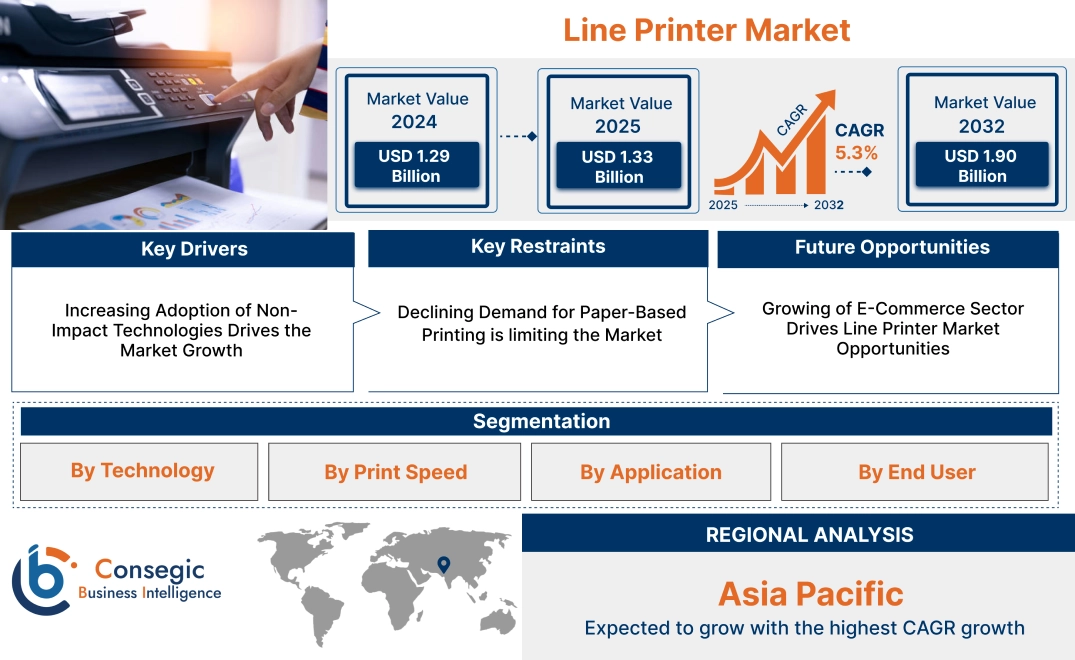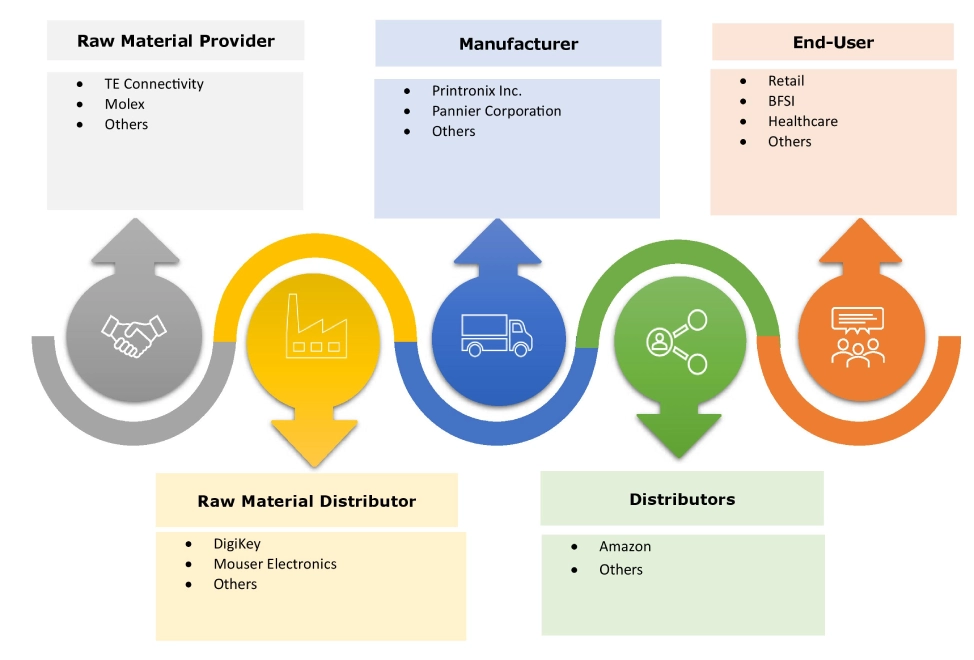- Summary
- Table Of Content
- Methodology
Line Printer Market Size:
Line Printer Market Size is estimated to reach over USD 1.90 Billion by 2032 from a value of USD 1.29 Billion in 2024 and is projected to grow by USD 1.33 Billion in 2025, growing at a CAGR of 5.3% from 2025 to 2032.
Line Printer Market Scope & Overview:
A line printer is a type of impact or non-impact printer that prints an entire line of text at once, rather than character by character or page by page. The printers are used for a wide range of applications in manufacturing, retail and logistics, BFSI, healthcare, and government. Further key trends driving the market include increasing need for high-quality and durable barcode and label printing across various industries, fueled by the growth of non-impact technologies like thermal and electrostatic printing. Additionally, the continued need for reliable and cost-effective printing solutions for high-volume applications is a significant factor driving the market.
Key Drivers:
Increasing Adoption of Non-Impact Technologies Drives the Market Growth
The increasing adoption of non-impact technologies is a significant driver for the line printer market. The non-impact methods like thermal printing and electrostatic printing offer superior print quality, higher speed, and quieter operation, making them increasingly important across various industries. Further, this technological shift caters to the growing need for precise and durable printing, particularly in applications such as barcode and label printing within pharmaceuticals, electronics manufacturing, and logistics.
- For instance, Printronix Inc. offers P8000 Open Pedestal, which is a cost-effective printer best, suited for environments where noise is not an issue. It has a small footprint, allows easy access to printed forms, and is a popular choice in manufacturing and transportation industries.
Thus, increasing adoption of the printer driven by a wide range of benefits including superior print quality and higher speed contributes significantly to the line printer market size.
Key Restraints:
Declining Demand for Paper-Based Printing is limiting the Market
The increasing shift towards digital communication, electronic documentation, and cloud-based storage is significantly limiting the market. Businesses and individuals are embracing paperless workflows and rely more on digital devices for information and transactions which results in declined requirements for physical printouts. Further, digitalization directly affects the need for high-volume printing solutions like printers, particularly in traditional sectors. Consequently, the overall market growth potential for printers is being constrained significantly by digitalization adoption.
Future Opportunities :
Growing of E-Commerce Sector Drives Line Printer Market Opportunities
The rising e-commerce sector presents significant growth opportunities for the line printer market. The exponential increase in online shopping necessitates efficient and reliable printing solutions for various logistical processes, including generating shipping labels, return labels, packing slips, and invoices. Further, non-impact models known for their speed and durability are well suited to handle high volumes in e-commerce fulfillment centers and warehouses. Furthermore, rising need for dependable printing in e-commerce creates a substantial need for providing tailored solutions that streamline shipping and logistics workflows.
- For instance, according to International Trade Administration, Global B2C e-commerce revenue is projected to reach USD 5.5 trillion by 2027, exhibiting a consistent 14.4% annual growth rate.
Thus, need for efficient and reliable printing solutions in e-commerce sector drives line printer market opportunities.
Line Printer Market Segmental Analysis :
By Technology:
Based on the technology, the market is segmented into impact line printers and non-impact line printers.
Trends in the Technology:
- Increasing emphasis on improving reliability and durability of impact printers to withstand harsh conditions and ensure minimal downtime, which in turn drives the line printer market trends.
- Increasing versatility in different types of media handling including different paperweights, sizes, and specialized label stocks which are expected to drive line printer market size.
Non-impact line printers arms accounted for the largest revenue share in the year 2024 and is anticipated to register the fastest CAGR during the forecast period.
- Increasing trend of continuous improvement in print quality, resolution, and precision offered by non-impact technologies like thermal and electrostatic printing is driving the line printer market share.
- Further, there is an increasing focus on enhancing printing speeds and overall throughput to meet the requirements of businesses with increasing printing volumes.
- Furthermore, growing incorporation of smart features such as remote management, predictive maintenance alerts, and seamless integration with cloud-based system drives the line printer market trends.
- Thus, as per analysis, advancements in print quality, increasing printing speeds, and integration of smart features are driving the market.
By Print Speed:
Based on the print speed, the market is segmented into low, mid, and high.
Trends in the Print Speed:
- The major trend in high-speed printers is the continuous advancement of non-impact printing technologies to achieve even faster printing speeds and higher throughput, which in turn drives the line printer market demand.
- Low-speed printers offer more compact designs and lower initial purchase costs in turn driving the line printer market share.
Mid accounted for the largest revenue share of 40.18% in the year 2024 and is anticipated to register the fastest CAGR during the forecast period.
- Mid-speed printers offer optimal balance between printing speed, purchase cost, and long-term reliability to cater to a broad range of business needs.
- Further, mid-speed printers are increasingly incorporating more sophisticated network connectivity options, security protocols, and user authentication features, which in turn drives the line printer industry.
- For instance, Oki Europe Ltd. offers The MX8050, which is a reliable printer, offered in pedestal and cabinet models, and is designed for critical back-office printing with fast paper loading. The printer offers a print speed of 500 lines per minute.
- Thus, as per line printer market analysis, aforementioned factors are driving the market.
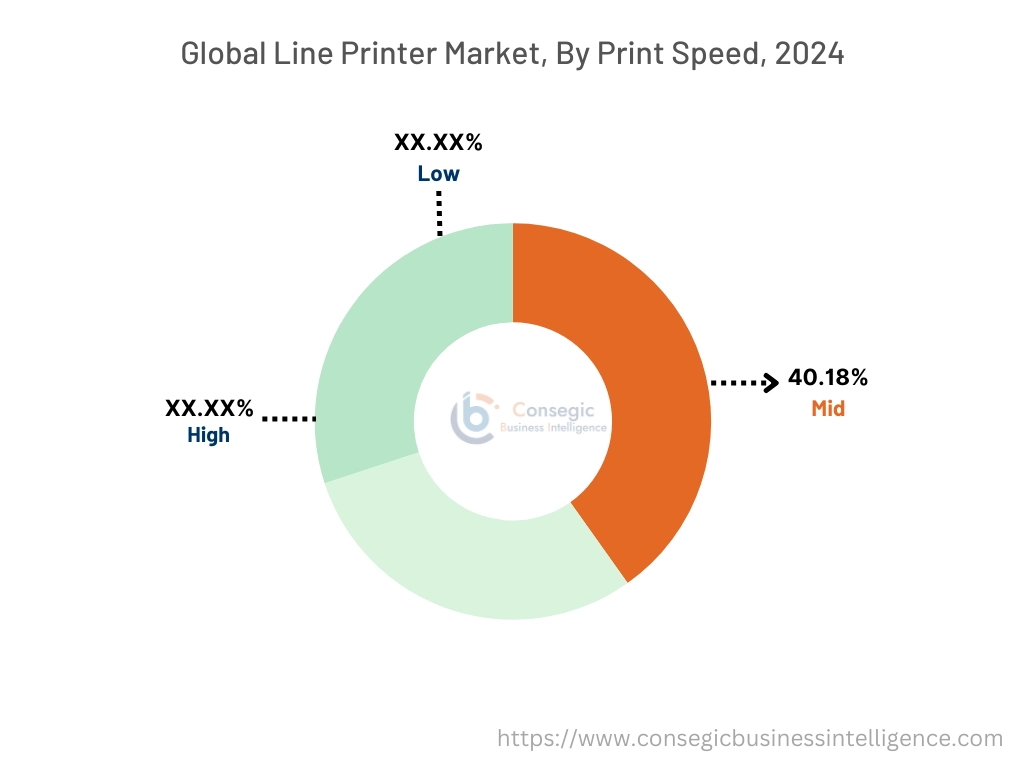
By Application:
Based on the application, the market is transaction printouts, report printing, barcode and label printing, document printing, and others.
Trends in the Application:
- There is a growing need for better print quality and more professional presentation of reports, which in turn drives the line printer market expansion.
- Businesses are increasingly adopting on-demand label printing systems to create labels as needed, reducing waste and allowing for greater flexibility in labeling requirements, which subsequently propels the line printer market demand.
Barcode and label printing accounted for the largest revenue share in the year 2024 and is anticipated to register the fastest CAGR during the forecast period.
- The growing need for higher print quality, durability, and legibility of barcodes and labels across industries including pharmaceuticals, logistics, and manufacturing.
- Further, growing retail and e-commerce industry is driving the need for barcode and label printing which in turn drives the line printer market growth.
- Furthermore, growing incorporation of more complex 2D barcodes (like QR codes) and RFID tags into printed labels to store more information, which in turn drives line printer market growth.
- For instance, according to IBEF, India's retail market is projected to expand significantly, reaching USD 1.6 trillion by 2026 with a robust annual growth rate of 10%. The growing retail sector will drive the need for barcode and label printing, which in turn drives the printing market.
- Thus, based on analysis, need for high-quality and durable labels, integration of 2D barcodes, and growing retail and e-commerce is driving the market.
By End-User:
Based on the end user, the market is segmented into manufacturing, retail and logistics, BFSI, healthcare, government and public sector, IT and telecommunication, and others.
Trends in the End User:
- Printing sensitive financial and personal information requires robust security features in printers to prevent unauthorized access or data breaches, which in turn drives the line printer market.
- Printers are being integrated with Electronic Health Record (EHR) systems to streamline the printing of patient charts, prescriptions, and others.
Manufacturing accounted for the largest revenue share in the year 2024.
- Stringent regulations and the need for precise product tracking throughout the supply chain are driving the need for durable labels.
- Further, printers are increasingly being integrated with industrial automation systems to provide real-time printing of labels.
- Furthermore, there is an increasing need for rugged printers that can withstand these conditions and provide consistent performance.
- Thus, as per line printer market analysis, need for robust and reliable printers, need for product tracking, and integration with industrial automation systems are driving the market.
Retail and logistics are anticipated to register the fastest CAGR during the forecast period.
- The boom in e-commerce has significantly increased the demand for efficient and reliable printing of shipping labels, return labels, and packing slips.
- Further, growing adoption of mobile line printing solutions within warehouses and retail environments propels the line printer market expansion.
- Furthermore, the high volumes of labels and documents required in retail and logistics necessitate cost-effective printing solutions, which in turn drive the market.
- For instance, Pannier Corporation offer in-line code printers, which is a straightforward and affordable method for marking moving products. These printers allow for message creation on a print wheel using individual characters or multi-character strips for easy alterations.
- Therefore, based on analysis, rise of e-commerce, adoption of mobile printing solutions, and focus on cost-effectiveness are anticipated to boost the market during the forecast period.
Regional Analysis:
The regions covered are North America, Europe, Asia Pacific, the Middle East and Africa, and Latin America.
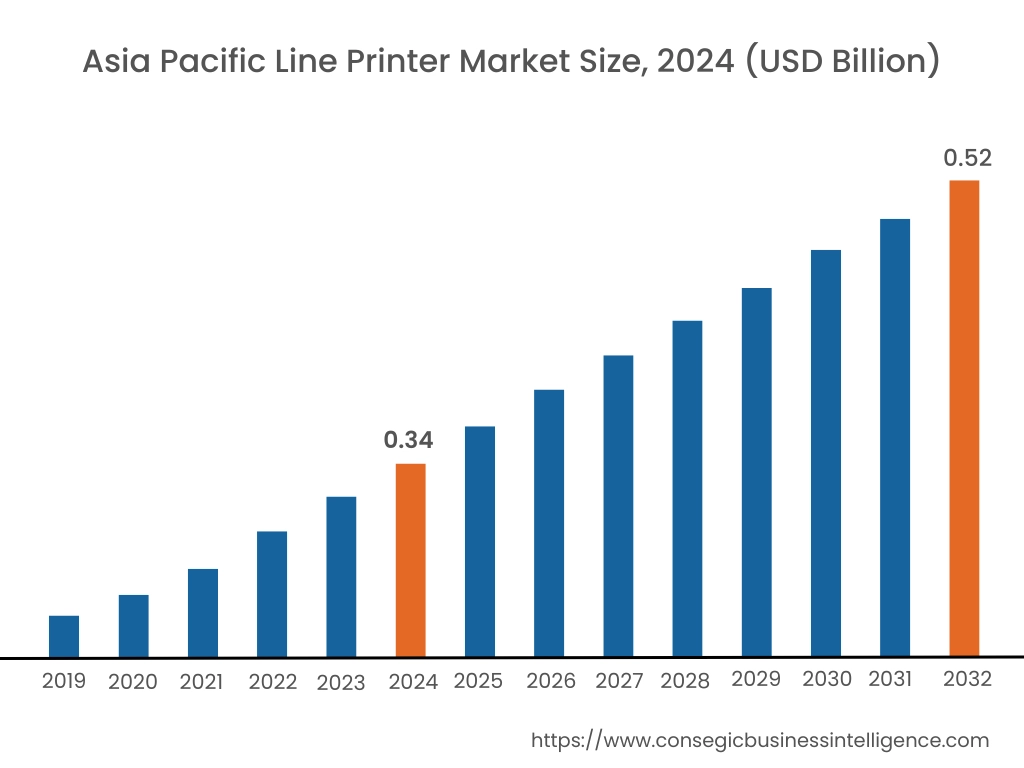
Asia Pacific region was valued at USD 0.34 Billion in 2024. Moreover, it is projected to grow by USD 0.36 Billion in 2025 and reach over USD 0.52 Billion by 2032. Out of this, China accounted for the maximum revenue share of 34.53%. The market for printers is mainly driven by rapid industrialization and expanding manufacturing sector, which necessitates reliable and cost-effective printing solutions. Additionally, growing e-commerce and retail industry is further driving the market.
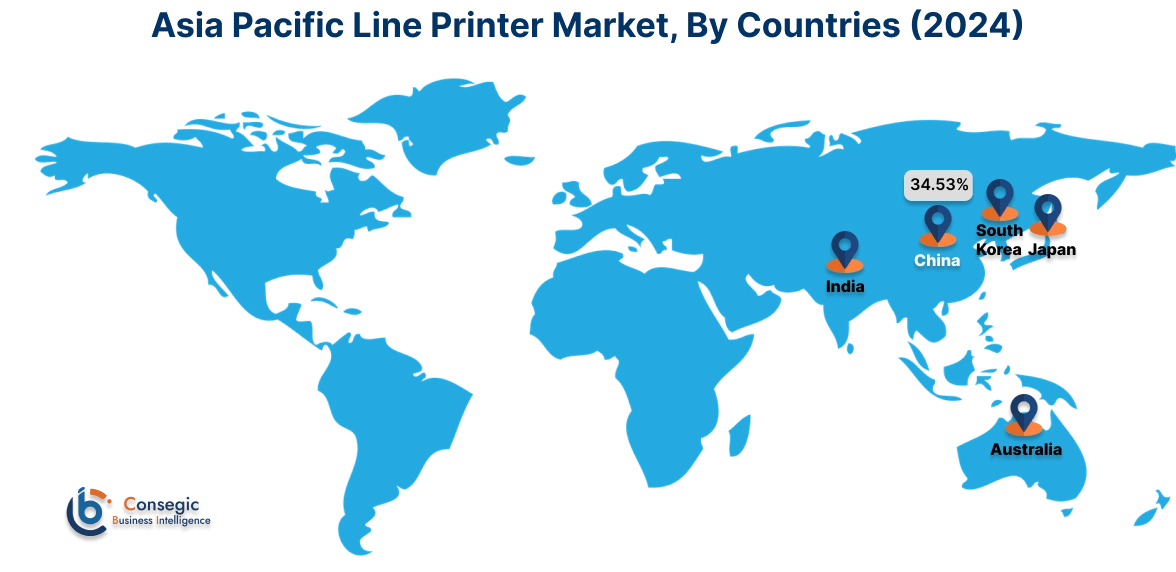
- For instance, according to International Trade Administration, India is projected to have the fastest retail e-commerce rise globally among major 20 countries between 2023 and 2027, boasting a CAGR of 14.1%.
North America is estimated to reach over USD 0.67 Billion by 2032 from a value of USD 0.46 Billion in 2024 and is projected to grow by USD 0.47 Billion in 2025. The North American market is primarily driven by continued demand of reliable and cost-effective printing solutions from key sectors such as manufacturing, logistics, and government.
- In June 2021, Printronix Inc. launched P8000 Plus printer series, featuring enhanced print quality, optional support for OpenPrint PDF & PostScript, and advanced network compatibility.
The regional analysis depicts that sustained demand in industrial and logistics sectors for reliable printing of labels, documents, and reports in Europe is driving the market. Additionally, the factor driving the market in the Middle East and African region is the adoption of more advanced non-impact printer technologies to enhance print quality and efficiency. Further, increasing urbanization and industrialization across the region is paving the way for the progress of market trends in Latin America region.
Top Key Players and Market Share Insights:
The global line printer market is highly competitive with major players providing solutions to the national and international markets. Key players are adopting several strategies in research and development (R&D), product innovation, and end-user launches to hold a strong position in the line printer industry. Key players in the global line printer market include-
- Printronix Inc. (US)
- Oki Europe Ltd. (UK)
- Pannier Corporation (US)
- Brother Industries (Japan)
- Canon (Japan)
- Xerox Corporation (US)
- Fujitsu (Japan)
- Hewlett-Packard Development Company (US)
- Ricoh Company
- Seiko Epson Corporation (Japan)
Line Printer Market Report Insights :
| Report Attributes | Report Details |
| Study Timeline | 2019-2032 |
| Market Size in 2032 | USD 1.90 Billion |
| CAGR (2025-2032) | 5.3% |
| By Technology |
|
| By Print Speed |
|
| By Application |
|
| By End-User |
|
| By Region |
|
| Key Players |
|
| North America | U.S. Canada Mexico |
| Europe | U.K. Germany France Spain Italy Russia Benelux Rest of Europe |
| APAC | China South Korea Japan India Australia ASEAN Rest of Asia-Pacific |
| Middle East and Africa | GCC Turkey South Africa Rest of MEA |
| LATAM | Brazil Argentina Chile Rest of LATAM |
| Report Coverage |
|
Key Questions Answered in the Report
How big is the Line Printer market? +
The Line Printer market is estimated to reach over USD 1.90 Billion by 2032 from a value of USD 1.29 Billion in 2024 and is projected to grow by USD 1.33 Billion in 2025, growing at a CAGR of 5.3% from 2025 to 2032.
What specific segmentation details are covered in the Line Printer report? +
The line printer report includes specific segmentation details for technology, print speed, application, end user, and regions.
Which is the fastest segment anticipated to affect the market growth? +
In the line printer market, non-impact line printers is the fastest-growing segment during the forecast period.
Who are the major players in the line printer market? +
The key participants in the Line Printer market are Printronix Inc. (US), Oki Europe Ltd. (UK), Pannier Corporation (US), Brother Industries (Japan), Canon (Japan), Xerox Corporation (US), Fujitsu (Japan), Hewlett-Packard Development Company (US), Ricoh Company, Seiko Epson Corporation (Japan), and others.
What are the key trends in the line printer market? +
The line printer market is being shaped by several key trends including shift towards non-impact printing technologies and continuous demand for printers in industrial sectors including manufacturing and logistics for reliable, high-volume printing of labels, reports, and barcodes.
